Ukulele JournalThe Journal of the Ukulele Hall of Fame
On this page we will present the Journal of the Ukulele Hall of Fame. The Journal will present both old and new articles about ukulele related topics. Articles available below:
Ukulele Ladies
by Tom Walsh
Exploring Some Early Ukulele Method Books and the Women Who Authored Them
There were a huge number of ukulele methods and songbooks published during the first nationwide surge in ukulele interest between 1915 and 1930. The vast majority of the ukulele books from this period were written by men. However, books by women were not unheard of. In this article, we'll take a closer look at a few of these method books, and the women behind them.
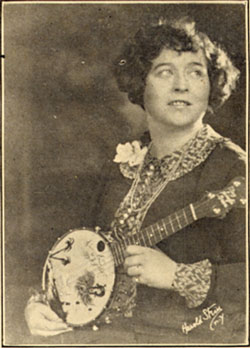
May Singhi Breen
|
May Singhi Breen was one of the most prominent ukulele book authors, male or female. She was the original "Ukulele Lady" - taking up the nickname years before the release of the popular song of the same name. She is the only one of the women authors discussed in this article who produced more than one ukulele book. She wrote a number of early method books. The first, May Singhi Breen's Ukulele Songs and Method 1, was published by the William J. Smith Co. in 1924. This is an in-depth method and songbook with the first 26 of its 56 pages devoted to chords, strokes, and exercises. In 1925 she and her husband Peter DeRose co-authored the Peter Pan Ukulele Method 2, which they published through their own company Uke-Trades Publishing. This method is much more basic than her previous method, with simple chords and songs that beginners could play. She is also credited as the editor on the 1925 Wendell Hall's Ukulele Method 3. Based on the similarities to the book published by William J. Smith, she almost certainly put together the music instructional materials at the beginning of this method. Breen also did the ukulele arrangements for a great many other songbooks, including the Remick Collection of Popular Songs with Ukulele Accompaniment, No. 7 4 (The first 4 volumes of this series were arranged by Zarh Myron Bickford, the husband of Vahdah Olcott Bickford - another of the authors in this article). Breen was an extremely prolific arranger for the ukulele and is credited with the idea of including ukulele chord diagrams on popular sheet music. Her contribution to ukulele instructionals also includes a 78 rpm record which was described in an ad in the Wendell Hall method as "A Six-Minute Course on How To Play The Ukulele" (Victor Record No. 19740). Her interest in the ukulele was life-long - she wrote a number of other ukulele books during the resurgence in interest in the ukulele in the early 1950s. May Singhi Breen is currently the only female inductee of the Ukulele Hall of Fame.
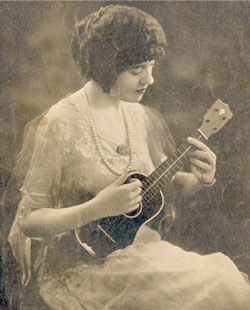
Vahdah Olcott-Bickford
|
Vahdah Olcott-Bickford and her husband Zarh Myron Bickford co-authored The Bickford Method for the Ukulele 5, which was published in 1920 by the Oliver Ditson Company. Bickford is renowned in the classical guitar world as an author, teacher and performer, and is considered "The pre-eminent American guitarist of the early 20th century" 6. She amassed one of the most important collections of guitar music anywhere. It is now housed at California State University, Northridge in what is called The International Guitar Research Archive. Zarh Myron Bickford was an accomplished stringed instrument player also, and did the arrangements for the first 4 volumes of the Remick Collection of Popular Songs with Ukulele Accompaniment 7 between 1917 and 1924. Born Ethel Lucretia Olcott and Myron Bickford, the couple's interest in astrology led them to take the "astrological names" Vahdah and Zarh 8. In the foreword to her ukulele method, she pushes for the use of "legitimate music notation" and maintains that ukulele chord diagrams "are a great detriment to the musical advancement of the pupil". Although it is clear she takes music seriously, she seems to not take the ukulele too seriously - she mentions that "No attempt has been made to make more out of the ukulele than its capacity warrants". The Bickford Method for the Ukulele was apparently Vahdah's only work for the instrument - she was highly involved in the classical guitar world for many years, but her interest in the ukulele was apparently not as long lasting.
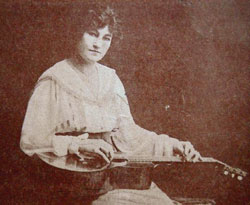
Myrtle Stumpf
(photo courtesy of Eric Stumpf)
|
Myrtle Stumpf authored Stumpf's Ukulele-Method and Solo Book 9, which was published in 1917 by The Southern California Music Company. Stumpf was a well-regarded steel guitar player who was a student of Joseph Kekuku 10, the person many regard as the inventor of the steel style of guitar playing. She wrote what may be the first published method for steel guitar in 1915. Stumpf was highly involved in the early world of Hawaiian stringed instruments. In the late teens she wrote for the Crescendo magazine in a column called the Hawaiian Round Table. She shared the authorship of the column with C. S. DeLano. DeLano was another well known steel guitar and ukulele player and instructor. The column carried all sorts of information about the ukulele and the steel guitar. Sadly, Stumpf died just as Hawaiian stringed instruments were entering their heyday. In the January, 1920 issue of Crescendo, C. S. DeLano mentions her passing with these words: "Permit me here to pay respectful tribute to Myrtle Stumpf, whose untimely death in October was a severe shock to her many friends. She was a lady of fine personality and a player and writer of ability". 11
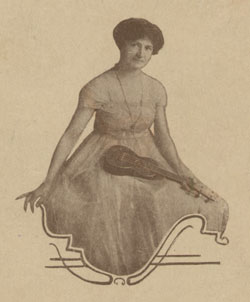
Jennie Durkee
|
Jennie Durkee is not as well known as some of the other female authors of ukulele methods. Her method, The American Way of Playing Ukulele Solos 12 came out in 1917 and was revised and copyrighted again in 1919 and 1920. It is one of few ukulele methods developed particularly to describe a playing technique using a "thick felt plectrum". She describes how the felt pick can be used with a "very rapid down and up stroke" to produce "a most desirable tremolo or sostenuto affect(sic). As far as we know, the method was Durkee's only published work. Her method book was apparently self-published originally, the cover reads "Published by Jennie M. Durkee, 2705 Kimball Ave., Chicago, Ill." Lyon and Healy later distributed her method - perhaps they picked it up to reward Durkee for the plug she gave them in the book. When discussing the various felt picks that were available she states, "The Lyon and Healy No. 5 pick is the best". Although she has no other known published works for the ukulele, Durkee did make at least one radio appearance. On May 20th 1922, the New York Times listed her in the column titled "Today's Radio Program". At 8:00 PM, Station KYW of Chicago aired both an "Ukulele Solo with Guitar accompaniment" and an "Ukulele Solo with Mandolin Accompaniment" by Jennie Durkee and Wayne Wadhams. 13
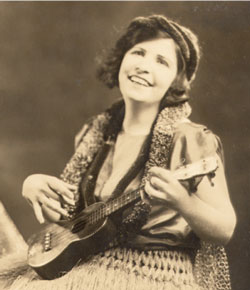
Angeline Nunes
(photo courtesy on Nuni Walsh)
|
Angeline Nunes co-authored The Original Method and Self-Instructor on the Ukulele 14 with A. A. Santos. Published in 1915, this was the first ukulele method written (actually co-written) by a woman. Angeline Nunes was the daughter-in-law of Hall of Fame Inductee Manuel Nunes, the ukulele maker (I should also mention that Angeline was the grandmother of my wife Nuni). She was married to Julius Nunes, Manuel's son who was the Nunes ukulele shop supervisor for a period of time.
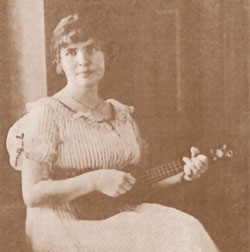
Angeline Nunes
|
The method book, published by Santos-Nunes Studios in Honolulu, is one of very few ukulele methods that actually was published in Hawaii. It is also unusual as it is the only ukulele method that uses the Maderian machete tuning, DGBD. All others use the modern GCEA (or ADF#B) tuning that was adapted from the tuning of the first four strings of the five-string portuguese instrument known as the raj„o 15. This method was Nunes' only published work associated with the instrument. Her career was as a school teacher - she taught a variety of subjects but specialized in music.
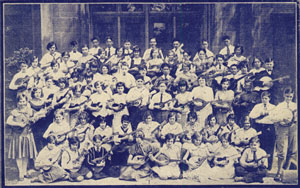
Class photo from "Goodwin's Class or
Group Ukulele Course"
|
Lucy Goodwin, of the Chicago Public Schools, authored Goodwin's Class or Group Ukulele Course 16 in the early 1930s. It is a guide for those intending to instruct large groups of ukulele players and describes itself as "Invaluable to Music Teachers and Supervisors, Recreational and Playground Directors, Camp Club and Group Leaders". Published by the M.M. Cole Publishing Co. of Chicago Illinois, this method also clearly is tied into the Harmony Musical Instruments Company (which was owned by another big Chicago company - Sears, Roebuck and Co.). The booklet has two full pages of pictures of "Typical Instruments Used for Plectrum Orchestras" and every instrument shown is clearly a Harmony Co. instrument. There is also a full page ad on the back of the booklet for the Harmony Classmate ukulele, available in standard size for $3.00 and Tenor size for $4.00. The tie-in with the method book is perfect, as it says in the ad "The 'Classmate' Ukulele is an especially designed standard approved instrument for group and class work". It goes on to describe how "your group will always make a lasting impression before any audience if all members are uniformly equipped with 'classmate' ukuleles". This is the only known published work by Goodwin and little is known about her except the information that appears in the book. In the foreword, she mentions that she has been teaching ukulele to children for five years, and that "the ukulele work of my pupils has become widely known and as widely appreciated; especially since the public have on numerous occasions heard the groups over the radio".
Notes:
1 May Singhi Breen, May Singhi Breen's Ukulele Songs and Method (New York: William J. Smith Music Co., 1924).
2 May Singhi Breen, and Peter DeRose, Peter Pan Uke Method (New York: Uke-Trades Pub. Co., 1925).
3 May Singhi Breen, ed., Wendell Hall's Ukulele Method (Chicago: Forster Music, 1925).
4 May Singhi Breen, arr., The Remick Collection of Popular Songs with Ukulele Accompaniment, No. 7 (New York: Jerome H. Remick & Co.: 1926).
5 Vahdah Olcott-Bickford and Zarh Myron Bickford, The Bickford Method for the Ukulele (Boston: Oliver Ditson Co., 1920).
6 John King, Famous Solos & Duets for the Ukulele (Pacific, Mo.: Mel Bay Publications, 2004).
7 Zarh Myron Bickford, arr., The Remick Collection of Popular Songs with Ukulele Accompaniment, No. 1-4 (New York: Jerome H. Remick & Co.: 1917-1924).
8 Ronald C. Purcell, Bickford, Vahdah Olcott (1885-1980), Biography from the International Guitar Research Archive web site posted at .
9 Myrtle Stumpf, Stumpf's Ukulele-Method and Solo Book (Los Angeles: The Southern California Music Co., 1917).
10 Myrtle Stumpf, Original Hawaiian Method for the Steel Guitar (Los Angeles: The Southern California Music Co., 1915).
11 C. S. DeLano, "The Hawaiian Round Table," Crescendo, Jan., 1920.
12 Jennie Durkee, The American Way of Playing Ukulele Solos (Chicago: Jennie Durkee, 1917)
13 "Today's Radio Program", New York Times, May 20, 1922.
14 A. A. Santos and Angeline Nunes, Original Method and Self-Instructor on the Ukulele (Honolulu: Santos-Nunes Studios, 1915).
15 John King and Jim Tranquada, "A New History of the Origins and Development of the 'Ukulele, 1838-1915," Hawaiian Journal of History, 37 (2003), 1-32.
16 Lucy J. Goodwin, Goodwin's Class or Group Ukulele Course (Chicago: M.M. Cole Publishing Co., circa 1932).
 Singing Senators and Ukulele Hitters: Singing Senators and Ukulele Hitters:
The Ukulele-Baseball Connection
by Tom Walsh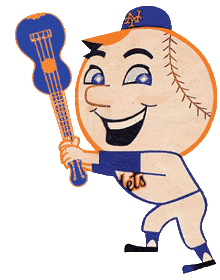 The ukulele has been around for almost as long as Major League baseball, and the little instrument has been linked to "America's Pastime" on numerous occasions throughout their respective histories. In this article we'll take a look at a few of the cases where baseball and the ukulele shared the spotlight. The 1920s were a very big decade for both the ukulele and for baseball. Each was entering an era of unprecedented popularity. Baseball's surge in popularity in the 1920s was largely due to the nation's fascination with the game's biggest star - Babe Ruth. Babe's home run hitting changed the way the game was played and his off the field behavior also brought him a great deal of attention. His appetite for hot dogs and beer is legendary, but his fascination with the ukulele isn't well known. Ruth himself played the ukulele, although by most accounts not very well. In a case of Ukulele Hall of Fame meets Baseball Hall of Fame, Ruth was a close personal friend of May Singhi Breen, the Ukulele Lady, and her husband, the composer Peter de Rose. Their friendship lasted from the 1920's right up until Ruth's death in 1948. When Ruth married his second wife, Claire Hodgson, in April of 1929, the Ruth's held a reception in their apartment on Riverside Drive where, as baseball writer Red Smith put it, "the 18th amendment did not apply". Peter de Rose and May Singhi Breen provided the entertainment. The couples remained close for many years, as mentioned by May's grandson Peter Bunch in a letter to the New York Times in 1999. The Times had run a photo of Babe Ruth near the end of his life in a hospital with an "unidentified boy". Bunch wrote to identify himself, and related that he was there due to the close relationship between his grandparents and Ruth. Two months after Ruth died, a benefit for the Babe Ruth Foundation was held at the Cardinal restaurant in New York City. Among the many stars who were involved were Henry Fonda, Jack Dempsey, Milton Berle, Vic Damone, Henny Youngman, Jackie Gleason and Phil Silvers. At the benefit, Mrs. Babe Ruth presided at the unveiling of the "Babe Ruth Corner", where Peter de Rose and May Singhi Breen premiered the new song "Babe" written by Peter de Rose and Charles Tobias. It was also during the1920s when the baseball term "ukulele hitter" became popular. It isn't heard much these days, but was a common description in its day, used by players and newspaper reporters alike. It refers to a player who hits primarily singles -someone without a lot of home run power. Like people all over America, many baseball players took up ukulele playing in the 1920s. The long train rides from city to city must have provided plenty of time for playing and practice. Jack Bentley, a pitcher for the Giants, Senators, and Phillies during a nine year career in the 1920s, was an accomplished ukulele player and singer. He occasionally was referred to as "Ukulele Jack Bentley". Unfortunately, sportswriters often liked to point out that his ukulele playing compared favorably to his pitching. In 1927, Tiny Owens, a pitcher for the Detroit Tigers, quit during spring training. It was reported that he objected to changes taking place in the game, such as "golf knickers, white flannels, tennis shoes and ukuleles around a baseball camp". Other baseball players who also played ukulele include Cliff Heathcoat, who played ukulele in the clubhouse with the Chicago Cubs team band in the mid 1920s and Lon Warneke, nicknamed the Arkanas Hummingbird, who played the ukulele in a band formed by his St. Louis Cardinals teammate, Pepper Martin. Also, the Hall of Fame catcher Mickey Cochrane could occasionally be found strumming his ukulele in the clubhouse. In 1934 the Phillies introduced a Hawaiian-born player, Henry Kawaihoa Oana. He was just the third Hawaiian-born player to play in the majors. Referred to as "Prince" Oana, the Phillies claimed he was descended from royalty, although Oana himself made no such claim. Before his debut, Prince Oana did admit that "I can play the uke a bit". His debut prompted sportswriter NY Times sportswriter John Kieran to write the following poem... Let the umpires gayly
Beat the Bally Drum
On the ukulele
Let the coaches strum
For Henry from Hawaii in the moonlight far away
Is in a diamond setting here and ready for the fray
He may be a terror
To the pitching clan
But he's made an error
In his baseball plan
In any really regal guise he'd take the town by storm
But, shucks! His royal raiment is a Phillies uniform
Before the Phillies stumble
In the baseball fight,
Give the Prince a tumble
While he's still in sight.
Ere the Phillies strike their stride (which means a downward rush)
Cheer the Prince and let us see a truly royal flush!
Another prominent baseball connection occurred in the 1950s. The radio and television announcer for the Washington Senators baseball team, Bob Wolff, also liked to sing and play ukulele. He formed a barbershop quartet type group composed of players from the Senators who sang along as Wolff strummed his ukulele. The "Singing Senators" gained acclaim, and in 1958 they made their debut on NBC's Today Show and entertained for a full 45 minutes in front of the reflecting pool in Washington, DC. Wolff was inducted into The Baseball Hall of Fame in 1995. He is surely the only Hall of Famer ever to play ukulele during his induction ceremony. What did he play? "Take me out to the Ball Game", naturally. References:
Smith, Red, Red Smith On Baseball, (Chicago: Ivan R. Dee, 2000)
William F McNeil, Gabby Hartnett, (North Carolina: McFarland & Company, 2004)
Floyd Connery, Baseball's Most Wanted ( Virginia: Brassey's Inc., 2003)
Nick Wilson, Voices from the Pastime (North Carolina: McFarland & Company, 2000)
Josh Lewin, Getting in the Game (Virginia: Brassey's Inc., 2003)
Marshall Smelser, The Life That Ruth Built (Nebraska: U of Nebraska Press, 1993)
Cross, Harry. "New Cards Await Weakened Giants" The New York Times 4 Jun. 1925, pg. 16
Kieran, John. "Sports of the Times" The New York Times 12 Mar. 1927, pg. 11
Kieran, John. "Sports of the Times" The New York Times 23 Dec. 1927, pg. 25
Kieran, John. "Sports of the Times" The New York Times 10 Jan. 1931, pg. 19
Kieran, John. "Two and Nothing" The New York Times 5 Oct. 1933, pg. 27
Kieran, John. "Sports of the Times" The New York Times 19 Apr. 1934, pg. 38
Daley, Arthur. "Sports of the Times" The New York Times 15 Jun. 1943, pg. 25
Harrison, James R. "Yankees Again Bow To The Tigers, 4-2" The New York Times 13 Jul. 1928, pg. 20
Sandomir, Richard Wolff "Ukulele Hitter Makes Hall of Fame as Broadcaster" The New York Times 31 Jul. 1995, pg C3
Altman, Lawrence K. M.D. "The Babe's Other Record: Cancer Pioneer" The New York Times 29 Dec. 1998, pg F1
 Unusual Ukuleles: Echo Ukes and the "Echo Device" Unusual Ukuleles: Echo Ukes and the "Echo Device"
by Tom Walsh
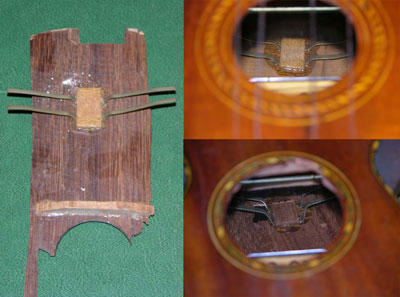
Echo Uke "Echo Devices". The two photos on the right were
taken with a mirror placed inside the ukulele body, in order
to show the reflection of the echo device. (Click to enlarge)
|
"Echo Uke" was a brand name of the Hawaiian Mahogany Company, a Honolulu ukulele manufacturer in the 1920s. Their ukuleles were sold in Hawaii as well as distributed on the mainland. Jules M. Sahlein of San Francisco sold Echo Ukes under the Y'Ke'Ke brand name and Schireson Brothers of Los Angeles sold them under the Mai Kai brand.
Some Echo Ukes include a special device apparently intended to add to the instrument's tone. This "Echo Device" was one or two strips of thin metal attached to the inside of the top of ukulele directly opposite to where the bridge is mounted.
The photograph on lthe left shows the echo device on a piece of the top from a badly damaged Y'Ke'Ke Echo Uke. The top and bottom photographs on the right are from a concert-sized Echo Uke and a soprano "Pele" model Echo Uke. These photos were taken by laying a small mirror inside of the ukuleles and catching the echo device's reflection through the ukulele's soundhole.
The labels of some Echo Ukes contain the claim "Echo Device Patented" but they list no patent number. Searches at the U.S. Patent and Trademark Office have yet to locate the patent.
|